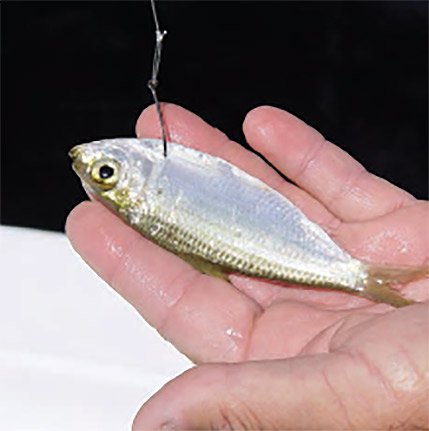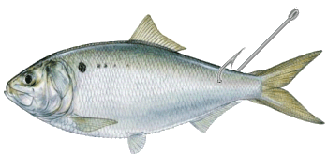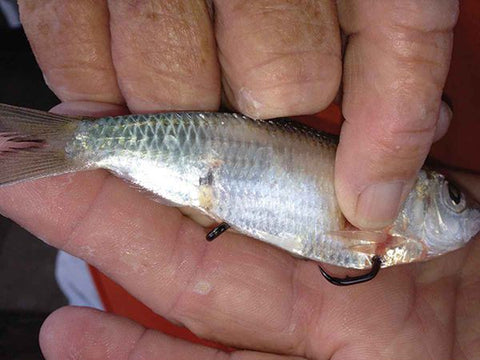Fishing With Live Bait: The Rigging Ultimate Guide
Fishing with live bait is one of the most effective ways to catch fish anywhere in the world. This is a tried and true method that has many advantages. The biggest advantage of using live bait is that it is a natural diet for the fish you are trying to catch, so it will have the scent, appearance, and texture that predatory fish will easily recognize.
The key to using live bait is all in the presentation of the bait to the fish. If the bait is presented in the wrong way, or in a non-natural position an angler’s chances of catching the desired fish may go down drastically. There are many ways to hook live bait and each has its purposes and benefits.
Baitfish
Nostrils/Jaw
Hooking a bait through the nostrils or jaw is one of the most popular ways to hook a bait. Hooking the bait this way allows it to swim naturally which is ideal for trolling or drifting offshore structures. Not only does this allow for a more natural appearance of the fish, but it will keep the bait from drowning.
Hooking a fish through the nostrils will cause the least harm to the bait, but is in a weaker area than through the bottom jaw to the top. Both positions allow the hook to be exposed which in turn will lead to easier hookups. This tactic works both smaller and larger baits.
Back/Dorsal

This hook placement is ideal for kite fishing, but can also be used for trolling, drifting offshore, free lining, or even pitching the bait towards free-swimming fish like Cobia. Hooking baits this way allows the bait to have a lot of action and swim as if it is hurt, attracting more predators.
This style of rigging makes the bait swim downwards similar to a lipped plug. To keep the fish alive the longest, be sure not to put the hook too deep into the fish. As with all other methods, avoid too many recasts to reduce shock.
Throat/Stomach

This placement is the ticket for getting the bait down into the water column near the bottom structure. This is the right tactic to use for stationary fishing on the bottom, jetties, piling/docks, or a seawall. Using a fishfinder rig you can keep the bait swimming at a preferred height off the bottom depending on the length of the leader.
Anal Fin/Tail

Hooking a bait near the tail or anal fin is a great way to hook bait to get action out of it, and to manipulate it into specific areas. This works the best when fishing from stationary positions like an anchored boat, pier/docks, jetties, or for casting at free swimmers.
Hooking a bait this way will cause it to swim away from the spot you are fishing from. Reeling the bait back will cause the fish to panic and swim aggressively away, giving more action and causing it to swim harder and further away towards the ideal spot.
Anal Vents

The final method of hooking bait is to run the hook through the bait’s anal vent and out through the gills. This is a perfect method for being anchored offshore on a reef or an inlet, or in a stationary boat position.
Since this will injure the fish, its life span will be shorter than most other hooking techniques, but this injury will cause the fish to move sporadically causing vibrations in the water. These vibrations will, in turn, lead to predatory fish being more attracted to the bait.
Shrimp
Head

The first place you can hook a live shrimp is in the head or body section. The proper location is right between the eyes and the dark area that is their digestive system. You want to hook the shrimp from side to side about 1/8” deep measure from the top.
Use this method with many hooks, circle and J hooks will work well. It will allow the most natural and realistic looking action from the live shrimp. It’s best suited for floating shrimp in a current where you aren’t usually trying to cast a mile.
Tail
There are various ways to hook live shrimp by the tail, it is the most popular method. The simplest method would be to take a circle hook and hook the shrimp in the first section above the tail. Side to side or top to bottom will have the same results.
That method is great for quick rigging and casting in a pinch. Removing the tail in that method will also result in scents being released that will also attract fish. Once you remove the tail, this opens up a few more ways to hook shrimp.
After removing the tail, use a J hook to thread the hook up the tail of the shrimp and pop it out once halfway up the hook - usually around the 4th section of the tail. This is a great hooking method for casting to fish that may be a little further.
In that method, there's much more meat for the bard to cling to before your live shrimp would fly off. However, your live shrimp still has an exposed hook that in certain scenarios could cause issues. Let's look at a weedless approach.
To make this method weedless thread a J hook through the first tailless section and bring it to the hook eye. Spin the hook around and now hide the hook in the meat of the shrimps tail. Weedless is a safer bet from weeds and structure, but slightly more difficult to get a solid hookup, I’ll leave that decision to you.
Crabs

Hooking live crabs for bait is a different ball game; their hard shells require a unique puncture. You must slowly twist the hook as you apply pressure to avoid cracking the shell. Aim for a section that is skinny and sticking out likely containing no inners, usually between two legs on one side right where it changes from legs to body.
Always puncture from below, bringing the hook through the top nice and easy. It’s a little tricky at first but after doing it a few times you will know how and when it feels right. Mastering this enables you to fish with a tough live bait not easily ripped off hooks by fish.
Whether you are rigging live bait or throwing artificial lures, make sure you stay protected on the water! What you wear fishing can make or break your next outing.


